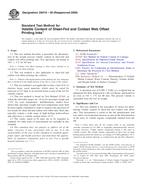We need your consent to use the individual data so that you can see information about your interests, among other things. Click "OK" to give your consent.
ASTM D5822-13
Standard Test Method for Determining Seam Strength in Inflatable Restraint Cushions
STANDARD published on 1.1.2013
The information about the standard:
Designation standards: ASTM D5822-13
Note: WITHDRAWN
Publication date standards: 1.1.2013
SKU: NS-32694
The number of pages: 6
Approximate weight : 18 g (0.04 lbs)
Country: American technical standard
Category: Technical standards ASTM
The category - similar standards:
Annotation of standard text ASTM D5822-13 :
Keywords:
airbag, cushion, inflatable restraint, seam efficiency, seam failure, seam strength, ICS Number Code 59.080.01 (Textiles in general)
Additional information
| Significance and Use | ||||||||
|
5.1 Seam strength testing is used for design validation and for lot acceptance. 5.2 This test method constitutes the conditions, procedures, and equipment by which either seams taken from inflatable restraint cushions, or seam types that can potentially be used for inflatable restraint cushions are tested for seam strength, seam efficiency, and failure mode. It is intended to be used as a guideline in establishing a written part specification or print. The specification or agreement of purchaser and supplier may deviate from the procedures described herein when (based on experience) considerations of equipment, cushion design, or other factors dictate otherwise. 5.3 In cases of dispute arising from differences in reported test results when using this test method for acceptance testing of commercial shipments, the purchaser and the supplier should perform comparative tests to determine if there is a statistical bias between their laboratories. Competent statistical assistance is recommended for the investigation of bias. As a minimum, the two parties should take a group of test specimens from the same lot of fabric to be evaluated, which utilize a like seam assembly (or standard seam assembly) to achieve seam interaction. The test specimens should then be randomly assigned in equal numbers to each laboratory for testing. If a bias is found, either its cause must be determined and corrected, or the purchaser and supplier must agree to interpret future test results in light of the known bias. 5.4 Test Method D5822 is a reliable test method but procedures which may require special attention are identified in the precision and bias section of this test method. |
||||||||
| 1. Scope | ||||||||
|
1.1 This test method covers the measurement of seam efficiency and the maximum seam strength in inflatable restraint cushions composed of woven fabrics when a force is applied perpendicular to the seam, using a grab test. For evaluating sewing thread, refer to Test Method D204. 1.2 This test method is restricted to seams that are either obtained from an inflatable restraint cushion or prepared off-line, specifically for testing, using fabric blanks, not obtained from a previously sewn cushion assembly. Seams may include but are not limited to sewn, OPW, glued, sealed and sewn, or fused (chemically or thermally). This test method can be used for either lot testing of production cushions, or for research and development purposes. 1.3 This test method is used when the measurement of a resistance to a specified force, a breaking force, a minimum elongation, or a combination thereof are required to determine the seam strength, or seam integrity of a particular fabric for inflatable restraint use. 1.4 Procedures and apparatus other than those stated in this standard may be used by agreement between purchaser and supplier with the specific deviations from the standard acknowledged in the report. 1.5 The values stated in either SI units or inch-pound units are to be regarded separately as standard. The values stated in each system are not exact equivalents; therefore, each system must be used independently of the other. 1.6 This standard does not purport to address all of the safety concerns, if any, associated with its use. It is the responsibility of the user of this standard to establish appropriate safety and health practices and determine the applicability of regulatory limitations prior to use. |
||||||||
| 2. Referenced Documents | ||||||||
|
Similar standards:
Historical
1.6.2013
Historical
1.1.2011
Historical
1.8.2008
Historical
1.12.2009
Historical
1.10.2008
Historical
1.2.2012
We recommend:
Technical standards updating
Do you want to make sure you use only the valid technical standards?
We can offer you a solution which will provide you a monthly overview concerning the updating of standards which you use.
Would you like to know more? Look at this page.



 ASTM D5548-13
ASTM D5548-13 ASTM D5591-04(2011)..
ASTM D5591-04(2011).. ASTM D629-08
ASTM D629-08 ASTM D6419-00(2009)..
ASTM D6419-00(2009).. ASTM D6773-08
ASTM D6773-08 ASTM D7785-12
ASTM D7785-12
 Cookies
Cookies
